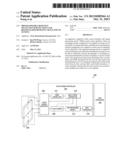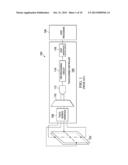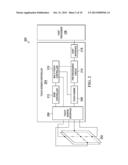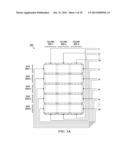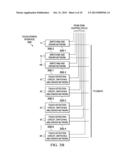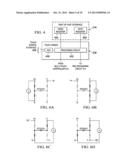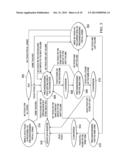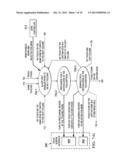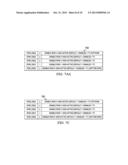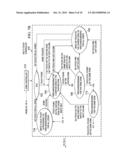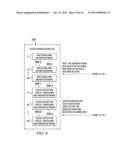Patent application title: PROGRAMMABLE RESISTIVE MULTI-TOUCH DETECTIONS AND REGIONALIZED RESISTIVE MULTI-TOUCH SENSING
Inventors:
Ing-Yih Wang (Tucson, AZ, US)
Texas Instruments Incorporated
Herbert Braisz (Tucson, AZ, US)
IPC8 Class: AG06F3041FI
USPC Class:
345173
Class name: Computer graphics processing and selective visual display systems display peripheral interface input device touch panel
Publication date: 2013-10-31
Patent application number: 20130285944
Abstract:
An apparatus comprises touch screen interface and signal processing
circuit. Within touch screen interface, there are switching circuits
configured to be coupled to at least one of a plurality of column
electrodes, and there are touch detection circuits configured to be
coupled to at least one of a plurality of row electrodes. The signal
processing circuit is coupled to each switching circuit and each touch
detection circuit so as to be able to selectively activate the plurality
of switching circuits and touch detection circuits to identify a zone for
a touch event. The signal processing circuit determines first, second,
third, and fourth resistances for the zone for the touch event and
determines a set of coordinates and pressure for the touch event from its
first, second, third, and fourth resistances. A zone controller, wherein
the first and second rows are previously enabled, but a third row is not
enabled.Claims:
1. A method for determining respective first and second positions for
first and second touch events that are substantially simultaneous on a
touch screen having a plurality of zones, the method comprising:
identifying a first zone of the plurality of zones, wherein the first
zone is associated with the first touch event; resolving the first
position in the first zone by: activating a first column and a first row
so as to measure first, second, third, and fourth resistances associated
with the first touch event; generating a first digital representation for
a first set of coordinates on the touch screen and a first pressure from
a set of the first, second, third, and fourth resistances; storing the
first digital representation; and deactivating the first column and the
first row; identifying a second zone of the plurality of zones, wherein
the second zone is associated with the second touch event; and resolving
the second position in the first zone by: activating a second column and
a second row so as to measure fifth, sixth, seventh, and eighth
resistances associated with the second touch event; generating a second
digital representation for a second set of coordinates on the touch
screen and a second pressure from the fifth, sixth, seventh, and eighth
resistances; storing the second digital representation; and deactivating
the second column and the second row, wherein the first and second rows
are previously enabled, but a third row is not enabled.
2. The method of claim 1, wherein the step of identifying the first zone further comprises performing a precharge and sensing operation for all zones to indicate the occurrence of the first touch event, and wherein the step of identifying the second zone further comprises performing a precharge and sensing operation for all zones to indicate the occurrence of the second touch event.
3. The method of claim 2, wherein the step of generating a first digital representation further comprises: calculating a horizontal position in the first zone corresponding to the first touch event from the first resistance, wherein the horizontal position corresponds to a first coordinate from the first set of coordinates; calculating a vertical position in the first zone corresponding to the first touch event from the first resistance, wherein the vertical position corresponds to a second coordinate from the first set of coordinates; calculating a touch resistance from the horizontal position, the first resistance, the third resistance, and the fourth resistance; and calculating the first pressure from the touch resistance.
4. The method of claim 2, wherein the step of generating a first digital representation further comprises: calculating a horizontal position in the first zone corresponding to the first touch event from the first resistance, wherein the horizontal position corresponds to a first coordinate from the first set of coordinates; calculating a vertical position in the first zone corresponding to the first touch event from the first resistance, wherein the vertical position corresponds to a second coordinate from the first set of coordinates; calculating a touch resistance from the horizontal position, the vertical position, the first resistance, the second resistance, the third resistance, and the fourth resistance; and calculating the first pressure from the touch resistance.
5. An apparatus comprising: a touch screen interface having: a plurality of switching circuits, wherein each switching circuit is configured to be coupled to at least one of a plurality of column electrodes; and a plurality of touch detection circuits, wherein each touch detection circuit is configured to be coupled to at least one of a plurality of row electrodes; and a signal processing circuit that is coupled to each switching circuit and each touch detection circuit, wherein the signal processing circuit is configured to selectively activate the plurality of switching circuits and the plurality of touch detection circuits to identify a zone for a touch event, and wherein the signal processing circuit is configured to determine first, second, third, and fourth resistances for the zone for the touch event, and wherein the signal processing circuit is configured to determine a set of coordinates and pressure for the touch event from its first, second, third, and fourth resistances; and a zone controller, wherein the first and second rows are previously enabled, but a third row is not enabled by the zone controller.
6. The apparatus of claim 5, wherein the signal processing circuit is configured to calculate: a horizontal position in the zone corresponding to the touch event from the first resistance, wherein the horizontal position corresponds to a first coordinate from the set of coordinates; a vertical position in the zone corresponding to the touch event from the first resistance, wherein the vertical position corresponds to a second coordinate from the set of coordinates; a touch resistance from the horizontal position, the first resistance, the third resistance, and the fourth resistance; and the first pressure from the touch resistance.
7. The apparatus of claim 6, wherein the signal processing circuit further comprises: a multi-touch controller that is coupled to the touch screen interface; and a touch engine that is coupled to the touch screen interface and the multi-touch controller.
8. The apparatus of claim 7, wherein the signal processing circuit further comprises a host controller that is coupled to the touch engine.
9. The apparatus of claim 8, wherein the touch engine further comprises: an analog-to-digital converter (ADC) that is coupled to the plurality of touch detection circuits; a touch engine controller that is coupled to the multi-touch controller, the ADC, and the host interface; and a pre-processing circuit that is coupled to the touch engine controller and the host interface.
10. The apparatus of claim 9, wherein the host interface further comprises: an index register for storing the zone for the touch event; and a data register for storing digital representations of the first and second resistances for the touch event.
11. An apparatus comprising: a touch screen having: a plurality of column electrodes; and a plurality of row electrodes; a touch screen controller having: a touch screen interface having: a plurality of switching circuits, wherein each switching circuit is coupled to at least one of the column electrodes; and a plurality of touch detection circuits, wherein each touch detection circuit is coupled to at least one of the row electrodes; and a signal processing circuit that is coupled to each switching circuit and each touch detection circuit, wherein the signal processing circuit is configured to selectively activate the plurality of switching circuits and the plurality of touch detection circuits to identify a zone for a touch event, and wherein the signal processing circuit is configured to determine first, second, third, and fourth resistances for the zone for the touch event, and wherein the signal processing circuit is configured to determine a set of coordinates and pressure for the touch event from the first, second, third, and fourth resistances; a host processor that is coupled to the signal processing circuit; and a zone controller, wherein the first and second rows are previously enabled, but a third row is not enabled by the zone controller.
12. The apparatus of claim 11, wherein the signal processing circuit is configured to calculate: a horizontal position in the zone corresponding to the touch event from the first resistance, wherein the horizontal position corresponds to a first coordinate from the set of coordinates; a vertical position in the zone corresponding to the touch event from the first resistance, wherein the vertical position corresponds to a second coordinate from the set of coordinates; a touch resistance from the horizontal position, the first resistance, the third resistance, and the fourth resistance; and the first pressure from the touch resistance.
13. The apparatus of claim 12, wherein the signal processing circuit further comprises: a multi-touch controller that is coupled to the touch screen interface; and a touch engine that is coupled to the touch screen interface and the multi-touch controller.
14. The apparatus of claim 13, wherein the signal processing circuit further comprises a host controller that is coupled between the touch engine and the host processor.
15. The apparatus of claim 14, wherein the touch engine further comprises: an analog-to-digital converter (ADC) that is coupled to the plurality of touch detection circuits; a touch engine controller that is coupled to the multi-touch controller, the ADC, and the host interface; and a pre-processing circuit that is coupled to the touch engine controller and the host interface.
16. The apparatus of claim 15, wherein the host interface further comprises: an index register for storing the zone for the touch event; and a data register for storing digital representations of the first and second resistances for the touch event.
17. The apparatus of claim 16, wherein the host interface further comprises an inter-integrated circuit (I2C) interface that is coupled to the host processor.
18. The apparatus of claim 17, wherein the touch screen has three columns and five rows.
19. The method of claim 1, further comprising enabling a fourth row.
Description:
PRIORITY
[0001] The present document claims priority from Provisional Application No. 61/610,752, filed Mar. 14, 2012, entitled "PROGRAMMABLE RESISTIVE MULTI-TOUCH DETECTIONS AND REGIONALIZED RESISTIVE MULTI-TOUCH SENSING" which is hereby incorporated by reference in its entirety.
TECHNICAL FIELD
[0002] The invention relates generally to a touch screen controller and, more particularly, to a resistive touch screen controller.
BACKGROUND
[0003] Turning to FIG. 1, an example of a conventional 4-wire interface system 100 can be seen. When a touch event occurs on the touch screen 102, the pressure applied to the touch screen 102 allows the column and row sheets of the touch screen 102 to intersect at the location of the touch event. To resolve this location, the touch screen interface 108 (which generally resides in the touch screen controller 104 and which can includes drivers and switches) is able to selectively activate the row sheet or column sheet of the touch screen 102 so at to allow the analog-to-digital converter (ADC) 112 (which can, for example, be a successive approximation register (SAR) ADC) to measure the resistances of for the row and column sheets. The pre-processing circuit 114 is then able to store the measured (and digitized) resistances and interpolate the position of the touch event on the touch screen 102. This interpolated position can then be passed to the host processor 106 though the host interface 116.
[0004] With these types of systems (i.e., system 100), there are some drawbacks. First, it is difficult to resolve multiple, simultaneous touch events with conventional 4-wire or 5-wire systems, usually requiring sophisticated algorithms to resolve the multiple, simultaneous touch events. Second, interpolation within the pre-processing circuit 114 can be costly in terms of power consumption and/or area. Therefore, there is a need for an improved resistive touch screen controller.
[0005] Some other conventional systems are: U.S. Pat. No. 6,492,979; U.S. Pat. No. 6,504,530; PCT Publ. No. WO2010117946; PCT Publ. No. WO2011087669; and Rick Downs, "Using resistive touch screens for human/machine interface," TI Analog Applications Journal, Third Quarter 2005.
SUMMARY
[0006] An embodiment of the present invention, accordingly, provides a method for determining respective first and second positions for first and second touch events that are substantially simultaneous on a touch screen having a plurality of zones. The method comprises identifying a first zone of the plurality of zones, wherein the first zone is associated with the first touch event; resolving the first position in the first zone by: activating a first column and a first row so as to measure first, second, third, and fourth resistances associated with the first touch event; generating a first digital representation for a first set of coordinates on the touch screen and a first pressure from a set of the first, second, third, and fourth resistances; storing the first digital representation; and deactivating the first column and the first row; identifying a second zone of the plurality of zones, wherein the second zone is associated with the second touch event; and resolving the second position in the first zone by: activating a second column and a second row so as to measure fifth, sixth, seventh, and eighth resistances associated with the second touch event; generating a second digital representation for a second set of coordinates on the touch screen and a second pressure from the fifth, sixth, seventh, and eighth resistances; storing the second digital representation; and deactivating the second column and the second row, wherein the first and second rows are previously enabled, but a third row is not enabled by the zone controller.
[0007] In accordance with an embodiment of the present invention, the step of identifying the first zone further comprises performing a precharge and sensing operation for all zones to indicate the occurrence of the first touch event, and wherein the step of identifying the second zone further comprises performing a precharge and sensing operation for all zones to indicate the occurrence of the second touch event.
[0008] In accordance with an embodiment of the present invention, the step of generating a first digital representation further comprises: calculating a horizontal position in the first zone corresponding to the first touch event from the first resistance, wherein the horizontal position corresponds to a first coordinate from the first set of coordinates; calculating a vertical position in the first zone corresponding to the first touch event from the first resistance, wherein the vertical position corresponds to a second coordinate from the first set of coordinates; calculating a touch resistance from the horizontal position, the first resistance, the third resistance, and the fourth resistance; and calculating the first pressure from the touch resistance.
[0009] In accordance with an embodiment of the present invention, the step of generating a first digital representation further comprises: calculating a horizontal position in the first zone corresponding to the first touch event from the first resistance, wherein the horizontal position corresponds to a first coordinate from the first set of coordinates; calculating a vertical position in the first zone corresponding to the first touch event from the first resistance, wherein the vertical position corresponds to a second coordinate from the first set of coordinates; calculating a touch resistance from the horizontal position, the vertical position, the first resistance, the second resistance, the third resistance, and the fourth resistance; and calculating the first pressure from the touch resistance.
[0010] In accordance with an embodiment of the present invention, an apparatus is provided. The apparatus comprises a touch screen interface having: a plurality of switching circuits, wherein each switching circuit is configured to be coupled to at least one of a plurality of column electrodes; and a plurality of touch detection circuits, wherein each touch detection circuit is configured to be coupled to at least one of a plurality of row electrodes; and a signal processing circuit that is coupled to each switching circuit and each touch detection circuit, wherein the signal processing circuit is configured to selectively activate the plurality of switching circuits and the plurality of touch detection circuits to identify a zone for a touch event, and wherein the signal processing circuit is configured to determine first, second, third, and fourth resistances for the zone for the touch event, and wherein the signal processing circuit is configured to determine a set of coordinates and pressure for the touch event from its first, second, third, and fourth resistances; and a zone controller, wherein the first and second rows are previously enabled, but a third row is not enabled by the zone controller.
[0011] In accordance with an embodiment of the present invention, the signal processing circuit is configured to calculate: a horizontal position in the zone corresponding to the touch event from the first resistance, wherein the horizontal position corresponds to a first coordinate from the set of coordinates; a vertical position in the zone corresponding to the touch event from the first resistance, wherein the vertical position corresponds to a second coordinate from the set of coordinates; a touch resistance from the horizontal position, the first resistance, the third resistance, and the fourth resistance; and the first pressure from the touch resistance.
[0012] In accordance with an embodiment of the present invention, the signal processing circuit further comprises: a multi-touch controller that is coupled to the touch screen interface; and a touch engine that is coupled to the touch screen interface and the multi-touch controller.
[0013] In accordance with an embodiment of the present invention, the signal processing circuit further comprises a host controller that is coupled to the touch engine.
[0014] In accordance with an embodiment of the present invention, the touch engine further comprises: an analog-to-digital converter (ADC) that is coupled to the plurality of touch detection circuits; a touch engine controller that is coupled to the multi-touch controller, the ADC, and the host interface; and a pre-processing circuit that is coupled to the touch engine controller and the host interface.
[0015] In accordance with an embodiment of the present invention, the host interface further comprises: an index register for storing the zone for the touch event; and a data register for storing digital representations of the first and second resistances for the touch event.
[0016] In accordance with an embodiment of the present invention, an apparatus is provided. The apparatus comprises a touch screen having: a plurality of column electrodes; and a plurality of row electrodes; a touch screen controller having: a touch screen interface having: a plurality of switching circuits, wherein each switching circuit is coupled to at least one of the column electrodes; and a plurality of touch detection circuits, wherein each touch detection circuit is coupled to at least one of the row electrodes; and a signal processing circuit that is coupled to each switching circuit and each touch detection circuit, wherein the signal processing circuit is configured to selectively activate the plurality of switching circuits and the plurality of touch detection circuits to identify a zone for a touch event, and wherein the signal processing circuit is configured to determine first, second, third, and fourth resistances for the zone for the touch event, and wherein the signal processing circuit is configured to determine a set of coordinates and pressure for the touch event from the first, second, third, and fourth resistances; and a host processor that is coupled to the signal processing circuit, and a zone controller, wherein the first and second rows are previously enabled, but a third row is not enabled by the zone controller.
[0017] In accordance with an embodiment of the present invention, the host interface further comprises an inter-integrated circuit (I2C) interface that is coupled to the host processor.
[0018] In accordance with an embodiment of the present invention, the touch screen has three columns and five rows.
[0019] The foregoing has outlined rather broadly the features and technical advantages of the present invention in order that the detailed description of the invention that follows may be better understood. Additional features and advantages of the invention will be described hereinafter which form the subject of the claims of the invention. It should be appreciated by those skilled in the art that the conception and the specific embodiment disclosed may be readily utilized as a basis for modifying or designing other structures for carrying out the same purposes of the present invention. It should also be realized by those skilled in the art that such equivalent constructions do not depart from the spirit and scope of the invention as set forth in the appended claims.
BRIEF DESCRIPTION OF THE DRAWINGS
[0020] For a more complete understanding of the present invention, and the advantages thereof, reference is now made to the following descriptions taken in conjunction with the accompanying drawings, in which:
[0021] FIG. 1 is a diagram of an example of a conventional interface system;
[0022] FIG. 2 is a diagram of an interface system in accordance with the present invention;
[0023] FIG. 3A and FIG. 3B are diagrams illustrating an example of the touch screen of FIG. 2;
[0024] FIG. 4 is a diagram of an example of the touch screen interface of FIG. 2;
[0025] FIG. 5 is a diagram illustrating the touch engine and host interface of FIG. 2;
[0026] FIG. 6A-6D are various approaches to measuring resistances at different touches;
[0027] FIG. 7Ai is a state diagram for an alternative aspect of the precharge/sensing for selected rows when used with a row enable state 504;
[0028] FIG. 7Aii is a register setting table of enabled and disabled rows within the pre-charge/sensing circuit of FIG. 7Ai and FIG. 7B.
[0029] FIG. 7B is a state diagram that includes how the pre-charge/sensing zone of 704; and
[0030] FIG. 7C illustrates is a register setting table of enabled and disabled rows within the pre-charge/sensing circuit of FIG.7B;
[0031] FIG. 8 is a diagram of the drivers of Touch Screen Interface 206 that run the alternative state diagram of FIG. 7B.
DETAILED DESCRIPTION
[0032] Refer now to the drawings wherein depicted elements are, for the sake of clarity, not necessarily shown to scale and wherein like or similar elements are designated by the same reference numeral through the several views.
[0033] As shown in FIGS. 2-4, the touch screen 202 and touch screen interface 206 of interface system 200 have a different configuration than that of the touch screen 102 and interface 108 of system 100. In this example, the touch screen 202 is divided into a number of column electrodes 302-1 to 302-3 and row electrodes 304-1 to 304-5 that are formed resistive sheets. In this example, there are three column electrodes (i.e., 302-1 to 302-3) and five row electrodes (i.e. 304-1 to 304-5), but other numbers of row and column electrodes are possible. For example, the number of row electrodes and/or column electrodes may be increase to increase resolution by increasing the number of "zones" (i.e., intersections of column and row electrodes). Coupled to each column electrode 302-1 to 302-3 is a switching circuit 306-1 to 306-3 (which generally resides in the touch screen interface 206 of the touch screen controller 204 and which also generally includes drivers to assist in sourcing current through the respective column electrodes), and coupled to each row electrode 304-1 to 304-5 is a touch detection circuit 308-1 to 308-5 (which generally resides in the touch screen interface 206 of the touch screen controller 204 and which also generally includes drivers and switches to assist in sourcing current through the respective row electrodes). By configuring the touch screen 202 and touch screen interface 206 as shown, the touch screen 202 can be better controlled; specifically, the signal processing circuit of touch screen controller 204 (which can generally comprise zone controller 212, touch engine 208, multi-touch controller 210 and host interface 216) is able to coarsely determine the "zone" of a touch event and finely resolve the position within the zone using the circuitry shown in FIG. 4 and the state diagram of FIG. 5.
[0034] Initially, in state 502, the signal processing circuit is at an idle state. While in state 502, the signal processing circuit can perform a precharge and sensing operation to determine whether a touch event (anywhere on the touch screen 202 has occurred). This is typically done by activating (with the multi-touch controller 210) all switching circuits 306-1 to 306-3 and all touch detection circuits 308-1 to 308-5 or by repeatedly scanning through the switching circuits 306-1 to 306-3 and touch detection circuits 308-1 to 308-5. This allow for coarse identification of the "zone" or intersecting row and column electrodes having a touch event. This zone can then be stored in the index register 408 of the host interface 216.
[0035] When the zone for a touch event has been identified, the characteristics of the touch can be resolved. Specifically, in state 504, the signal processing circuit (by way of the zone controller 212 and multi-touch controller 210) can perform a precharge and sensing operation for the column associated with the identified zone. Typically, the signal processing circuit activates or applies as voltage (i.e., voltage V) across the column electrode (i.e., 302-1) associated with the zone.
[0036] As shown in FIG. 6B, a resistance measurement is performed by the touch detection circuit (i.e., 308-1) associated with the zone. This strip resistance RY (which corresponds to the associated column) can be converted by ADC 402, touch engine controller 404, and pre-processing circuit 214 in state 506 to a digital representation of the vertical (or "Y") coordinate within the identified zone, which can be stored in data register 406 in state 516.
[0037] Then, in state 508, the signal processing circuit can perform a precharge and sensing operation for the row associated with the identified zone. Typically, the signal processing circuit activates or applies as voltage (i.e., voltage V) across the row electrode (i.e., 304-1) associated with the zone
[0038] As shown in FIG. 6A, a resistance measurement is performed by the touch detection circuit (i.e., 308-1) associated with the zone. This strip resistance RX (which corresponds to the associated row) can be converted by ADC 402, touch engine controller 404, and pre-processing circuit 214 in state 510 to a digital representation of the horizontal (or "X") coordinate within the identified zone, which can be stored in data register 406 in state 516. In some circumstances (i.e., where no pressure measurement is desired), state 516 can be entered from state 510.
[0039] In instances where a pressure measurement is desired, the pressure (or "Z" coordinate) can be determined in states 512 and 514 and stored in the data register 406 in state 516. (after a determination that there has been no change in the zone in state 512). To do this, two resistance measurements are made.
[0040] As shown in FIG. 6c and 6D, a voltage V is applied across the positive terminal for the column electrode associated with the identified zone (i.e., 302-1) and the negative terminal for the row electrode associated with the identified zone (i.e., 304-1). The first pressure-related resistance measurement Z1 is then determined from the positive terminal for the row electrode associated with the identified zone (i.e., 304-1), and the second pressure-related resistance measurement Z2 is determined from the negative terminal for the column electrode associated with the identified zone (i.e., 302-1). With these resistance measurements, the touch resistance RTOUCH can be calculated as follows:
RTOUCH = R X X 4096 ( Z 2 Z 1 - 1 ) ; or ( 1 ) RTOUCH = R X X 4096 ( 4096 Z 1 - 1 ) - R Y ( 1 - Y 4096 ) , ( 2 ) ##EQU00001##
where X is the horizontal position or coordinate within the identified zone, Y is the vertical position or coordinate within the identified zone, RX and RY are the strip resistances, and Z1 and Z2 are the pressure-related resistance measurements. The touch resistance RTOUCH is proportional to the pressure applied to the touch screen, so the ADC 402, touch engine controller 208, and pre-processing circuit 214 in state 514 can both calculated the touch resistance RTOUCH and pressure, which can be stored in data register 406 in state 516.
[0041] Following the of the update of the data register 406 with the pressure (or "Z") coordinate, the signal processing circuit can perform a precharge and sensing operation to determine whether a touch event anywhere else on the touch screen 202 has occurred in state 518. States 504 to 516 can then be repeated for additional touch events other zones. Additionally, because interaction with a touch screen 202 in interactive, touch events change, as, for example, fingers are moved across the touch screen, the state diagram includes several state changes reflecting these types of changes. With most of the state changes, the columns and/or row can be switched or cycled (i.e., activations of successive columns electrodes 302-1 to 302-3 and/or row electrodes 304-1 to 304-5).
[0042] Thus, by using the system 200, several benefits can be realized. First, power consumption can be reduced over that of system 100. Second, multi-touch capability (i.e., between difference zone) can be realized without the use of more exotic algorithms.
[0043] FIG. 7Ai illustrates an alternative embodiment of the pre-charge for a selected zone. Generally, the state 504 has been expanded to allow for a touch to be determined on only some rows, but not on others. Regionalizing the multi-touch sensor for the application of activating certain portions of the screen for touch functions. Implementing the structure of multiple touch detection circuitries to be programmably enabled or disabled to achieve the regional touch functions.
[0044] In the state 704-1, a touch was previously found in state 702, or some touches have previously occurred in a state 718, or no touch had previously occurred in the same zone, so therefore the next column is checked in a 708 and 712, thereby looping to state 704-1. In a state 704-3, there is no touch on the certain zone, but a switch to the next column has occurred, and loops back to state 704-1.
[0045] However, state 704-1 only allows for a detection on an enabled row, as received from the Zone controller 212, to determine if touches has occur, and therefore advance to the state 704-2.
[0046] For purposes of explanation, a touch has indeed occurred on the selected row.
[0047] In a state 704-2, a pre-charge procedure for the corresponding zone at the touched row occurs and, in the mean time, turns on precharge drivers of enabled rows in the 808 blocks of Touch Screen Interface 206. Then, the state advances to a state 704-3.
[0048] In a state 704-3, a sensing procedure occurs for the certain zone at the touched row.
[0049] In the state 704-3, one of four cases then occur, either a touch found at a certain zone but store index only that are updated in the state 516, a touch found on the certain zone then advancing to the state 506 to do Y Conversion, no touch on the certain zone but switch to the next column then returning back to the state 704-1, or no touch and the last column then advancing to the state 720 to do precharge/sensing for all zones.
[0050] From 704-2 and 704-3, three tasks are invoked in Touch Screen Interface 206: turning on precharge drivers at the touched row, turning on touch detection circuits at the touched row, and turning on sensing drivers of selected columns.
[0051] FIG. 7Aii illustrates a row enable table 750. As is illustrated, various rows of 304-1 through 304-5 of FIG. 3A are enabled or disabled.
[0052] FIG. 7B illustrates a how the state 704 would then advance through the various states as a basis of the touch of the selected rows, as implemented with an alternative embodiment of the zone controller 212. As is illustrated, the pre-charge/sensing state would advance to a state 506 or 516. However, as is illustrated, the state 712, 718 and 720, which correspond to states 512, 518 and 520 of FIG. 5 each instead are directed towards a lesser number of rows being enabled. Please note that only enabled rows and selected columns are used in the solid outlined blocks.
[0053] The state 712, 718 and 720 are essentially the same as the previous state 512, 518 and 520. The state 512, 518 and 520 proceeds when all rows are enabled instead.
[0054] Use the multiple touch detection circuitries on rows and columns to activate multi-touch detections on a certain region or divided regions for the different functional purposes at certain periods of time. Advantages of the approach regionalize touch screen panel for some certain functions and consume less power.
[0055] However, in these rows, only certain rows are enabled by the zone controller 212 using the row enable table 750.
[0056] FIG. 7C illustrates the row enable table 750 that delineates the various rows enables and disables as may be enabled by the zone controller
[0057] Referring back to FIG. 3A, coupled to each column electrode 302-1 to 302-3 is a switching circuit 806-1 to 806-3 (which generally resides in the touch screen interface 206 of the touch screen controller 204 and which also generally includes drivers to assist in sourcing current through the respective column electrodes), and coupled to each row electrode 304-1 to 304-5 is a touch detection circuit 808-1 to 808-5 (which generally resides in the touch screen interface 206 of the touch screen controller 204 and which also generally includes drivers and switches to assist in sourcing current through the respective row electrodes).
[0058] By configuring the touch screen 202 and touch screen interface 206 as shown, the touch screen 202 can be better controlled; specifically, the signal processing circuit of touch screen controller 204 (which can generally comprise zone controller 212, touch engine 208, multi-touch controller 210 and host interface 216) is able to coarsely determine the "zone" of a touch event and finely resolve the position within the zone using the circuitry shown in FIG. 4 and the state diagram of FIG. 7B.
[0059] Having thus described the present invention by reference to certain of its preferred embodiments, it is noted that the embodiments disclosed are illustrative rather than limiting in nature and that a wide range of variations, modifications, changes, and substitutions are contemplated in the foregoing disclosure and, in some instances, some features of the present invention may be employed without a corresponding use of the other features. Accordingly, it is appropriate that the appended claims be construed broadly and in a manner consistent with the scope of the invention.
User Contributions:
Comment about this patent or add new information about this topic:
| People who visited this patent also read: | |
| Patent application number | Title |
|---|---|
| 20190114478 | HANDWRITING AUTO-COMPLETE FUNCTION |
| 20190114477 | TERMINAL APPARATUS, INFORMATION PROCESSING SYSTEM, AND METHOD OF PROCESSING INFORMATION |
| 20190114476 | VEHICLE IMAGING SYSTEM, VEHICLE IMAGING METHOD AND DEVICE, PROGRAM, AND RECORDING MEDIUM |
| 20190114475 | VEHICLE IMAGING SYSTEM, VEHICLE IMAGING METHOD AND DEVICE, PROGRAM, AND RECORDING MEDIUM |
| 20190114474 | VISUAL PERCEPTION ASSISTANT |

